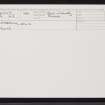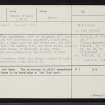Lewis, Adabrock
Bead(S) (Amber)(Bronze Age), Bead (Gold)(Bronze Age), Bead (Glass)(Bronze Age), Hoard (Bronze)(Bronze Age), Socketed Axehead(S) (Bronze)(Bronze Age), Spearhead (Bronze)(Bronze Age)
Site Name Lewis, Adabrock
Classification Bead(S) (Amber)(Bronze Age), Bead (Gold)(Bronze Age), Bead (Glass)(Bronze Age), Hoard (Bronze)(Bronze Age), Socketed Axehead(S) (Bronze)(Bronze Age), Spearhead (Bronze)(Bronze Age)
Alternative Name(s) Ness
Canmore ID 4438
Site Number NB56SW 6
NGR NB 53 62
NGR Description NB c. 53 62
Datum OSGB36 - NGR
Permalink http://canmore.org.uk/site/4438
- Council Western Isles
- Parish Barvas
- Former Region Western Isles Islands Area
- Former District Western Isles
- Former County Ross And Cromarty
NB56SW 6 c. 53 62.
A hoard of bronze implements, with two fragments of a beaten bronze vessel "of considerable capacity", a gold bead, two amber beads, a glass bead and two whetstones, all dating from the late 7th century BC., was found during peat-digging by Donald Murray of Adabrock, in May, 1910. The finds were purchased by the National Museum of Antiquities of Scotland (NMAS) in 1910 (DQ 211-227).
(In his treatise, Coles also cites a number of authorities for comparisons - see list in 2).
J Anderson 1911; J M Coles 1962; Proc Soc Antiq Scot 1920.
Mr Murray is now dead. The discovery is still remembered locally but there is no knowledge of the find spot.
Visited by OS (R L) 14 June 1969.
Hoard, found in a peat moss about 1910 when digging peats; the objects were c. 9 to 10 feet below the surface, arranged in a heap with the smaller objects lying on top of the larger.
1046. (Socketed axe of Portree type). Slightly corroded, rough surface, brown untrimmed, blade hammered, short haft ribs; length 67mm, mouth 24 x 28mm, cutting edge 49mm, weight 145 gms> NMAS DQ 212.
1233. (Socketed axe; Aylsham variant of Meldreth type). Slightly corroded, brown, partly trimmed, haft ribs, hammered cutting edge; length 106mm, mouth 23 x 27mm, cutting edge 56mm, weight 195 gms. NMAS DQ 211.
Other associated finds: one leaf-shaped spearhead; one socketed hammer with a mouth moulding; one socketed gouge, collared, with recurved blade; one shouldered and tanged chisel; three tanged and perforated razors with a notched blade; two fragments of a beaten-bronze vessel, the rim fragment has a decoration of incised hanging triangles below the rim, there are traces of rivet holes, the vessel was probably shouldered; one gold bead, hollow; two amber beads with flat sides; one blue glass bead with cracked surface; two whetstones, one of sandstone, one of claystone.
P K Schmidt and C B Burgess 1981.
Two amber beads (NMAS accession number DQ 223-4) found as part of a group of objects, smaller objects lying above larger, in 1910 by peat digging in the parish of Moss. Two socketed axes, spearhead, socketed gouge, socketed hammer, tanged chisel, three razors, bronze vessel fragments, gold bead two whetstones.
Both beads are medium sized, irregular, round, with a drop-shaped longitudinal section. The beads are 16mm and 19mm long and 10mm and 11.5mm thick respectively. Date 7th century BC.
C Beck and S Shennan 1991.










